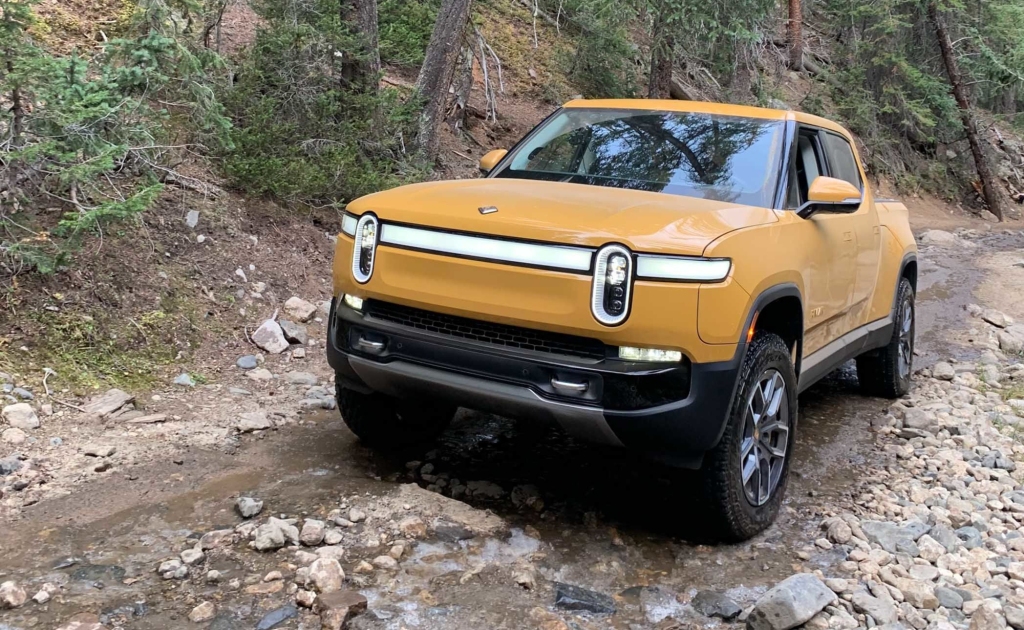How is a upstart truck maker without a product for sale one of America’s most valuable companies?
Irvine-based Rivian is certainly a gambit, but funding partners such as Ford Motor and Amazon believe it likely will become a serious player in the electric truck business. It went public this week, selling shares on Wall Street for the first time with an enthusiastic reception that gave it a market valuation of $127 billion as of Friday.
If the concept of billions makes your head hurt, ponder this: Rivian is worth roughly the same as the combined market values of four Asian automakers with U.S. headquarters in Southern California — Honda, Hyundai, Kia and Mazda.
Or look at it this way: Only 68 U.S. public companies are worth more, according to Companiesmarketcap.com.
Yes, stock markets do crazy things with wild concepts. Yes, investors have been wrong before. And the market value of a company that’s just beginning to make its vehicles seems rich, to my blood.
However, when I looked at the public companies of comparable stock value, a common theme emerged: They once seemed like long-shot dreams, too.
Without any suggestion that Rivian’s “the next big thing,” let’s ponder some of the U.S. businesses valued on Friday roughly the same as the fledgling EV truck maker. And note, most of these brand-name corporations are far older than 12-year-old Rivian.
Raytheon Technologies (market capitalization of $134 billion): This defense contractor started making radio tubes in the 1920s and grew into a major radar maker, the creator of the air-to-air Patriot Missile, as well as the inventor of the microwave.
Starbucks ($132 billion): A half-century ago, a Seattle coffee roaster began revolutionizing the morning cup of Joe — turning what was seen as a cheap, low-quality morning drink into an all-day, luxury beverage with global appeal.
Bristol-Myers Squibb ($132 billion): The drug giant’s history goes back to Navy doctor Ed Squibb inventing a better ether in the 1850s. Today, after numerous acquisitions and divestitures — including selling off Excedrin — it may be best known for its blood thinner, coumadin.
AirBnB ($132 billion): The house-rental service evolved from a 2007 concept by two young San Francisco young adults who created a “bed and breakfast” business by renting out an air mattress in their living room.
Boeing ($130 billion): The planemaker and defense contractor’s roots date to Seattle businessman William Boeing’s 1916 idea that he could grow his lumber business into that era’s craze — flying machines.
Target ($127 billion): When banker George Dayton’s Minneapolis church needed cash in 1906, he bought its surplus land and built what eventually would become Dayton-Hudson department stores. Six decades later, discounter Target was started, and the legacy department stores were jettisoned in 2004.
Intuitive Surgical ($127 billion): In 1994, Fredrick Moll brought the idea of robotic surgery to his then-employer, medical device maker Guidant. When they said no thanks, he quit and eventually his company’s “da Vinci” system became a surgical standard.
Estee Lauder ($125 billion): The post-World War II creation of New Yorkers Estee and Joseph Lauder, the cosmetics company ballooned in value by making high-end products for both women (Clinique) and men (Aramis).
Charter Communications ($124 billion): In the early 1980s, paying for TV seemed crazy when the major networks provided it for free. Michigan-bred Charter began winning controls to wire cities for cable TV. Its history is complicated and includes bankruptcy and the eventual acquisition of giant Time-Warner Cable.
CVS Health ($124 billion): The retailer started as the Consumer Value Store, selling beauty products in Massachusetts in the 1960s. Today’s CVS’s value heft came from a 1996 stock offering that allowed it to buy an insurer (Aetna) and gobble up competitors to create its national drug store chain.
American Tower ($124 billion): You likely use their products daily. It’s a 1998 spinoff from the CBS entertainment empire that saw opportunity in buying old microwave towers, used for long-distance phone transmission. It turned the real estate into facilities that power cell service.
Amgen ($119 billion): The Thousand Oaks drug company — originally Applied Molecular Genetics when it started in 1980 — used novel manufacturing techniques to first boost cancer patient survival rates. It’s now better known for Enbrel, an arthritis treatment.
General Electric ($118 billion): Yes, the company was founded by inventor Thomas Edison in 1892. Its more modern innovations included pioneering the “conglomerate” concept of owning a wide collection of businesses. That tactic is out of favor, so it’s planning to split into three distinct companies.
Snowflake ($116 billion): Like Rivian, a young company at nine years old. This Silicon Valley-bred supplier of “cloud” computing systems had a record-setting stock offering late last year. Recently, it said it’s becoming headquarter-less — with key executives operating out of Montana.
Jonathan Lansner is business columnist for the Southern California News Group. He can be reached at jlansner@scng.com










